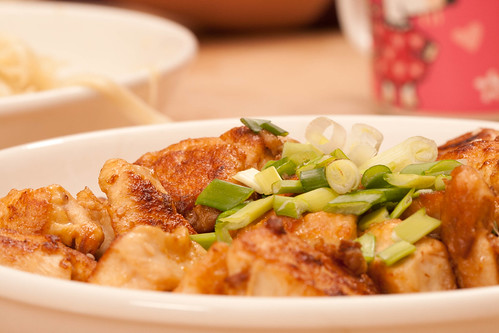
Stroganoff, for most of you, is associated with the Russian dish boeuf stroganoff, a creamy sauce based on thin beef tenderloin strips and perhaps button mushrooms (interestingly, mushrooms aren't included in böfstrooganov over here). But stroganoff it's also used as a shorthand for various hot dishes using long and thin meat strips. Say, something you'd probably call pork or beef stir-fry strips in English-speaking countries, are called stroganoff pieces over here (you can also buy "maksastrooganov" or thin beef or pork liver strips over here).
Here's a popular Estonian family dinner - oven-baked pork stroganoff that uses less than five ingredients (pork, onions, mushrooms, mayonnaise and seasonings). It tastes lovely with some mashed or simply boiled potatoes, and is a perfect for those cold winter nights.
More stroganoff recipes here on Nami-Nami:
Latvian pork stroganoff "Kurzeme stroganoff"
Mushroom stroganoff
Oven-baked pork stroganoff with mayonnaise
(Sealihast ahjustrooganov majoneesiga)
Serves 4
500 g lean pork (stroganoff/stir-fry strips)
2 large onions
250 g white or button or cremini mushrooms
225 g mayonnaise (I used the local Jaani Provansaal mayo)
salt and freshly ground black pepper
vegetable oil, for frying
To garnish:
fresh chives, finely chopped
Pre-heat the oven to 200 C/400 F. Lightly oil a medium-sized oven casserole dish, put aside.
Peel the onions, halve and cut into thin slices. Clean the mushrooms and cut into thin slices.
Heat oil on a heavy skillet/frying pan, add the pork and fry until lightly browned on all sides. Season to taste with salt and pepper. Put into a casserole dish.
Fry the onions on the same pan, adding some oil, if needed. You don't need to caramelise the onions - around 5 minutes, until the onions are just starting to soften, is all you need.
Scatter the fried onions and the sliced mushrooms on top of the pork. Drizzle or spoon the mayonnaise on top.
Cook in a preheated 200 C oven for about 30 minutes, until the meat and mushrooms are cooked and the mayonnaise topping is lovely light golden brown.
Garnish with chopped chives, and serve with either simple boiled potatoes or mashed potatoes.















